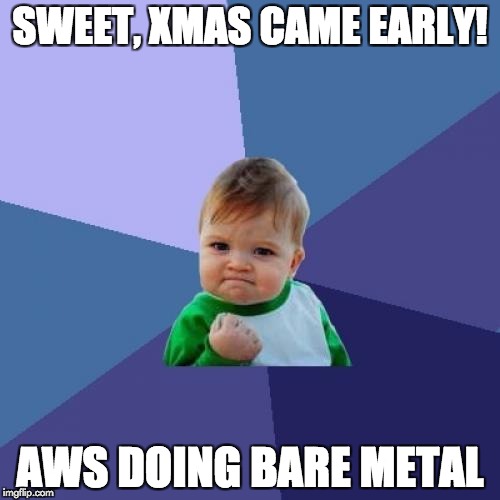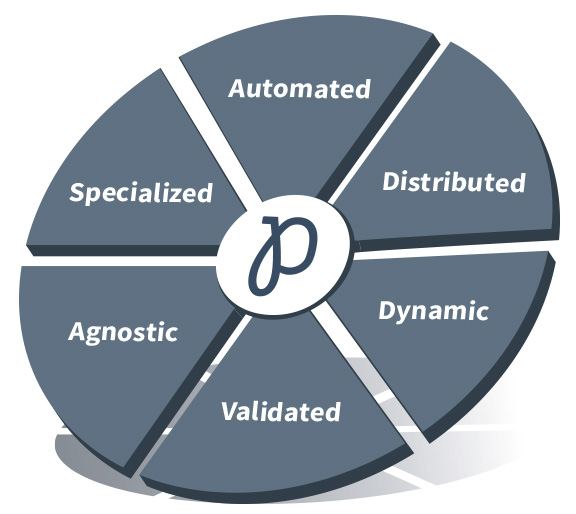Why We Can’t Wait for AWS to Announce Bare Metal
The history of AWS is based on automation through virtualization, but I bet its future won’t be. Here's why we're laying down the welcome mat.

A friend called me this past weekend, a bit giddy. He wanted to know if I had heard the rumor about AWS releasing a bare metal product at next month’s re:Invent conference. Was it true? Were we worried?
The undercurrent was clear: we should be worried! Amazon “The Crusher” Web Services was extending its golden tentacles into our peaceful little bare metal market. Over were the days when the fiercest competition for the hearts and minds of next-generation metal aficionados was Oracle (honestly, what are OCPUs anyways?). Gasp!
You can imagine the surprise in his voice when instead of running in panic from this potential news, I responded: “Really? That’s fantastic!!”

Allow me to explain.
Tilting at Windmills...or at the Future?
There is a large dose of paralysis in the cloud infrastructure business today, as everyone watches AWS and the rest of the “hyperscale” providers rapidly move the entire world of IT into virtualization based cloud services. At Packet (now Equinix Metal), we call this Cloud 1.0 - and without a doubt the scale and velocity of this shift “to the cloud” is exhilarating.
However, the sound of AWS, Azure and Google sucking up all the IT workload is a bit deafening, and it can be hard to concentrate on the future - what we call Cloud 2.0. If the first wave of the cloud made it possible to deliver IT through automated, remote, virtualized infrastructure, will this same approach power the massive workloads of tomorrow - such as IoT and autonomous vehicles? Generic VM’s in Ashburn? Probably not.
Our passion for the last 4 years has been about automating fundamental infrastructure - bare metal if you please. That’s because we see more specialized, and less opinionated (e.g. less inherently multi-tenant or virtualized), infrastructure as the future. That’s why we won’t be surprised if AWS starts delivering its automated infrastructure as “bare metal” - it is a big part of what’s next.
So Why Is Packet Excited?
If AWS does in fact release a bare metal (or similar) product, there are a few obvious reasons why we’re excited about it, and not afraid of it:
- Open Software is Winning - If AWS (the current king of proprietary cloud software and service) is offering a bare metal product, it means that open source portable software is winning. AWS joining CNCF (the home of Kubernetes), the massive surge of competitive open source projects (think Lambda-like offerings) and the endless march of alternative database, pipelining, event computing and IoT software stacks is starting to be the dominant player in cloud, not AWS. We have always believed that open software would eat away at the “lock in” approach, and it is coming fast and furious. This is a world we have been building for, so it is naturally exciting for us Packeteers.
- Market and Product Validation - If there is one thing we’ve done at Packet, it has been to stay laser focused on unopinionated “bare metal” infrastructure: why it matters, why it is so important to the next cloud wave, and how to deal with it at scale. If one of AWS’ product announcements is a move into bare metal, that’s a strong thumbs up that our “spidey sense” is well tuned.
- More Noise about Bare Metal - If it is true, and AWS starts selling and promoting a bare metal product, it would be absolutely awesome for Packet. AWS can take over the hard work of making bare metal relevant in a big way, and we can start more of our client conversations about value and strategy, instead of “vm based cloud” vs “bare metal cloud”. Nice!
The Less Clear Benefits
I’ve written in the past about how to thrive in a “post Amazon” world, and so it’s not surprising that we see a future shaped by new trends and forces. In fact, we think those will be bigger and more disruptive than the ones that created the “Cloud 1.0” tsunami that is driving earnings, investments and growth today for AWS and the other massive players.
- The Table is Set - An AWS bare metal product will no doubt be fully automated and built to scale hugely. This will set pretty high table stakes for anybody else that wants to play in Cloud 2.0. In short, you better figure out your metal automation! Otherwise, you’ll be left sitting on the sidelines while AWS and other agile players who understand the new customer eat up Cloud 2.0.
- Forced Virtualization / Multi-Tenancy is Passe - Infrastructure automation in Cloud 1.0 has been delivered with a required dose of virtualization (and usually multi-tenancy) to make it all work. With a bare metal offering, AWS could enable its customers to remove that virtualization performance tax, or avoid the pain of nested virtualization. We think this will further accelerate awareness of specialized infrastructure - the amazingly valuable knobs and widgets that Intel, Qualcomm, Mellanox, and others invest billions of dollars to invent and produce...only to have it hidden away behind a hypervisor.
- Other Architectures Get a Boost - While I’m not convinced that an AWS product would let you truly touch the hardware, I think promoting a bare metal offering exposes what’s under the hood: and increasingly that means x86 and something else - be it Arm, AMD, OpenPower, etc. This will help software like Kubernetes accelerate its early investments into knowing the hardware (e.g. device plugins) - helping users to extract value from a massive variety of hardware.
- De-Commoditization of Compute - For the last ten years we’ve been on a race to simplify IT with generic compute units and droplets that smooth out the rough edges and remove the “speeds and feeds” fascination of the IT buyer. But as software becomes the default consumer, and the workloads gets WAY bigger, there will be a push to get more value out of hardware...and that means knowing about the details. Not only if there is SSD or NVMe or Optane in a particular machine, but what model - not to mention which networks it is connected to. Bare metal isn’t just about getting full access to a bigger machine - it is about touching and understanding the hardware so you (or your software) can make the best use of it.
This Isn’t about VMware, It’s About Kubernetes
Rumors about Amazon’s bare metal product started percolating last year after the announcement of VMware Cloud on AWS. And while the target market for an AWS bare metal product could be established software ecosystems like VMware that need a “cloud home”, I really think this all makes sense because of Kubernetes.
Kubernetes, and its related cloud native brothers and sisters, represent the Achilles-heel of Cloud 1.0. The vertical “lock you in” model works well when that workload is difficult or impossible to move around, and when the software (like the RDS database service) is superior to open source alternatives. But the promise - and fast emerging reality - of the cloud native ecosystem is that it’s not hard to move, and that open source is moving faster than even Amazon can. It’s built to be hyper-portable from the get go, and has the benefit of the crowd (just ask Quantopian about the power of crowd-sourcing incredibly hard things).
Obviously, Kubernetes is all the rage these days. No doubt it will be featured at re:Invent in various products and customer examples. But the real winner here is what Kubernetes stands for: powerful, smart, open software that enables portability and handles immense complexity.
Exposing the Core Value: Logistics
There’s no denying AWS’ dominance in today’s market, and its ability to innovate rapidly is impressive. That’s why I’m confident that whatever is announced at re:Invent this year (including a fleet of AI or machine learning services) will be both big and polished, helping AWS to keep their momentum flowing.
The interesting question to me is: why? As this post shows, I can only guess at what AWS will do next - but I’m pretty confident that we can trace it back to their core value as a company.
My theory is that AWS has seen the writing on the wall for a long time: open software is going to tear down the “vertical” value proposition of today’s Cloud 1.0 growth engine. Even AWS can’t hold off the onslaught, and so it is time to invest in what’s next: highly efficient and specialized servers running open software that work all the way back down to the metal (or silicon, as it were).
There is money in open source software, and no doubt AWS will have strong managed Kubernetes services. But for AWS, this isn’t about software - open or closed. It’s about the thing they do better than anyone else in the world: logistics.
AWS deploys something like 40,000 racks of servers each year. If the next wave of growth is about designing, building, deploying, and managing complex and diverse infrastructure needed to support IoT, interactive gaming, autonomous vehicles, and tele-medicine at scale - then Amazon’s core skill of delivering diapers in an hour is sure to be an advantage.
Welcome to Selling Servers on the Internet!
Coming full circle, we are excited by the idea of AWS releasing a bare metal product. In the simplest terms, it’s the kind of market change that speaks to the entire reason we started Packet just over three years ago: with a mission to build a better internet by automating the heck out of fundamental infrastructure.
It was a bet on open source, and a bet on new workloads being far bigger than the ones we see today. It was a leap of faith that specialized hardware would come to market, and need a path to innovators who rely on automation. It was a hunch that infrastructure would need to be in a lot of places, instead of just a few centralized ones.
In short, we’ve designed Packet as a company ready to lead “what’s next”. And that’s why we’ve built everything we do around what we think infrastructure will look like in 5-10 years. Check out the words below and let us know what you think.

I certainly do hope that Christmas comes early this year. My wish is that more interest in bare metal (i.e. fundamental infrastructure), will help to move the next wave of innovation forward. With more people touching innovative hardware directly, the vision that Packet has for infrastructure is likely to accelerate immensely - giving wings to businesses new and old, and to the biggest driver of them all: software.
Welcome to selling servers on the internet, AWS. :)